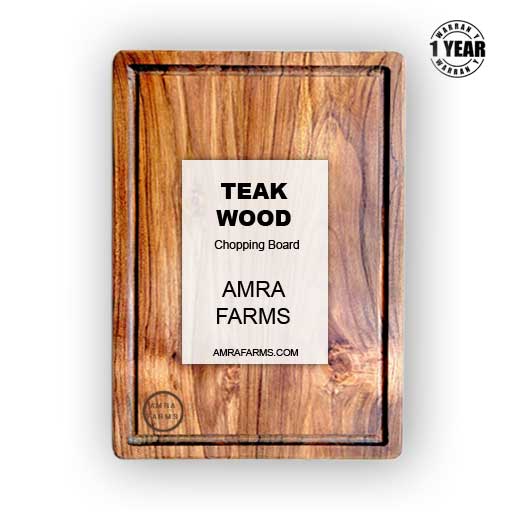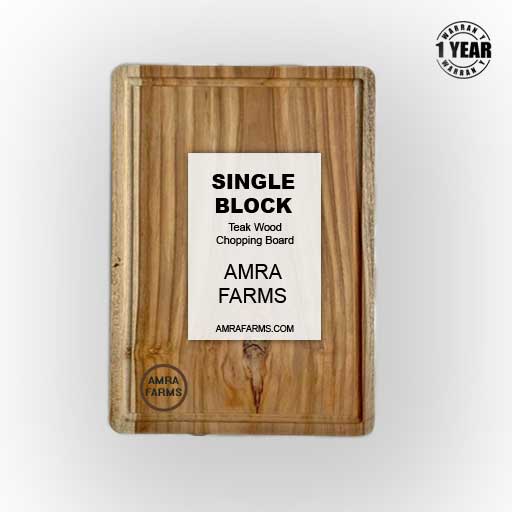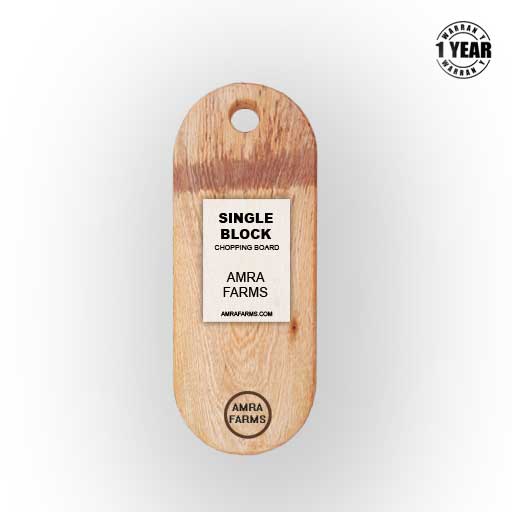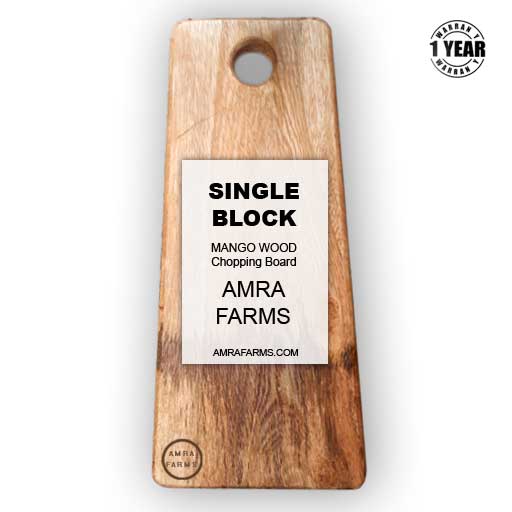Your cart is currently empty!
Edge Grain vs End Grain Chopping Boards – Which Should You Pick for Your Kitchen?
When purchasing a wooden chopping board, you have a lot of options in terms of wood. There are teak, mango wood, acacia and neem among a lot of others. To add to the confusion, there are also the types of chopping boards based on the construction. You may have come across the two terms that sound very similar: Edge Grain and End Grain. They refer to the way the boards are constructed and the difference is more than technical. It affects durability, price and how the board behaves with your knives.
This article dives into the difference between edge grain and end grain cutting boards and helps figure out the best board for your kitchen style. We will also explore how each of these boards is cared for to keep them in their best shape.
What is an Edge Grain Chopping Board?
An Edge Grain cutting board is made by arranging wood strips side by side with their edge facing the sides. This creates a smooth surface with the fibres going side to side. The linear grain pattern looks clean and elegant on any countertop. Edge Grain cutting boards are commonly used with teak, maple, mango, walnut and acacia wood. All bamboo cutting boards you see in the market too are Edge Grain cutting boards.
Edge Grain cutting boards are affordable, durable, less porous. They are easy to construct and are less complicated. They come in single block and joint types. Edge Grain cutting boards are perfect for daily use, easy to clean and maintain, and look great in a modern kitchen with a sleek grain pattern.
However, the fibres run along the surface where your kitchen knives cut through the fibre making visible marks over time. This dulls your knife faster and cuts down the life of your board over time.
Recommended products
Teak Wood Butcher Board (15 x 12 x 1 inch)
₹4,999.00Teak wood Meat Chopping Board (15 x 12 x 1 inch)
Original price was: ₹2,499.00.₹1,445.00Current price is: ₹1,445.00.Teak wood Steak Cutting & Serving Board (15 x 12 x 1 inch)
Original price was: ₹4,999.00.₹4,099.00Current price is: ₹4,099.00.Premium Single Wood Teak Chopping Board (15 x 12 x 1 inch)
₹1,999.00 – ₹2,999.00
What is an End Grain Cutting Board
An End Grain cutting board is constructed with the end facing upwards, where the open end of the wood with the fibres facing upwards. This is considered the gold standard for chefs. With the end facing upwards, the knife does not cut through the fibres but cuts into it. End Grain cutting boards are constructed by gluing multiple wooden pieces together. They come in various patterns and artisans are free to create a wide range of designs for these boards. The most common one is the checkered boards, but there are pyramid shapes, and even 3D designs which are a spectacle and art in itself.
The fibres of the wood act like a natural cushion for the knives allowing it to slide between them. This protects the knife and the board heals itself ensuring the life of the board is longer and your knives remain sharper for long.
An End Grain cutting board is more valuable than expensive. The board lasts longer than Edge Grain cutting boards and ensures your knife remains in shape and sharp for longer. With a self-healing surface, knife marks are rarely visible. Ideal for heavy chopping like meat and root vegetables or even herbs, End Grain cutting boards are not just functional but a visual treat. With a good artisan, the beauty of the board is limitless. Combined with the beauty of wood like sheesham and teak, the beauty of the End Grain cutting board is worth every single penny spent.
End Grain Cutting Board vs Edge Grain Cutting Board
| Feature | Edge Grain | End Grain |
|---|---|---|
| Construction | Long wood strips (side grain) | Wood blocks with fibres upright |
| Knife-friendliness | Moderate | Excellent (blade-preserving) |
| Durability | Good for light to medium tasks | Outstanding for heavy-duty use |
| Maintenance | Low | Needs regular oiling |
| Appearance | Linear grain | Checkerboard pattern |
| Price | More budget-friendly | Usually more expensive |
Which Chopping Board is Right for You?
Understanding the features and limitations of each board helps match your board type to your cooking style.
Go for an Edge Grain cutting board if:
You are a home cook looking for a budget-friendly, durable board. Edge Grain boards are affordable and work great for home cooks. They are easy to clean and maintenance is low. While used regularly, they do not have to be intense as in a professional kitchen. The use at a home is moderate to low in most cases. Edge Grain cutting boards are great for cutting vegetables, fruits. You can cut meat occasionally too.
Go for an End Grain cutting board if:
You are a professional cook and are looking to cut more and often. If you cut meat regularly and are looking for a high-quality butcher block that lasts years. These are the times when you really need an End Grain chopping board. Yes, these boards are becoming popular and more and more people can afford it now. Instagram videos of home cooks like to flaunt the End Grain cutting boards these days and it’s a great investment for them. They look beautiful, they are functional and have all the benefits of an Edge Grain cutting board and more.
How to Care for Your Wooden Chopping Board
Caring for both the Edge Grain and End Grain cutting board is the same. The difference is in the frequency of maintenance. End Grain cutting boards often require lesser maintenance in terms of frequency while Edge Grain cutting boards tend to require more care and are often known to scratch marks on the surface which requires an occasional sanding. An End Grain cutting board requires lesser care, but is not void of care altogether.
Normal care and maintenance tasks should be performed on both boards equally. Always remember to keep your board clean. Do not let food dry on the board. Wash immediately after you finish cutting. Wipe clean with a cloth and keep the board upright to air it well. Oil the board when it feels dry. Never soak in water for long or use the dishwasher to wash your wooden cutting boards, both End Grain or Edge Grain. Do not use harsh chemicals either. Use a mild soap at all times.
What are Some Common Myths About Wooden Cutting Boards?
- Wood harbours more bacteria than plastic:
Wrong. Wood is actually more food-safe than plastic. As a matter of fact, wood is naturally antibacterial, self-healing and food-safe. Being organic, wood has an edge over plastic too. Plastic is often associated with health hazards. Experts say that you consume at least 3 credit cards worth of plastic every year from a chopping board. What makes it worse is that plastic boards tend to develop knife marks and deep grooves over time, trapping bacteria. With wood like teak, its high antibacterial features make it safe even after years of use. - All wooden boards are the same:
No. The type of wood and the construction both are important and make for different functionality. Wood like teak is more durable, dense and highly antibacterial. They are rich in natural oil, scratch-resistant and make for a perfect chopping board. Wood like mango is relatively light and is best for chopping bread and vegetables. The construction too makes a lot of difference. Joined wood, Edge Grain chopping boards are often less durable while single block chopping boards are more durable. Every wood and every type of construction changes how the chopping board performs. - You don’t have to oil your End Grain cutting boards:
Not true. You need to oil all wooden cutting boards to ensure that the natural oil content of the board is maintained. This prevents the wood from cracking, warping and ensures the beauty and shine of the wood is well maintained. This applies to End Grain cutting boards and Edge Grain cutting boards. No exceptions.
When choosing a cutting board type, choose Edge Grain cutting boards if you are a home cook and have low or moderate cutting needs. We would encourage you to purchase an End Grain board if you are looking for a display board. For instance, if you are an influencer or a cooking video creator, an End Grain cutting board is great to add to your collection. Most home cooks and even professional chefs love the Edge Grain cutting board. But if you are looking to cut a lot of meat and looking for a combination of butcher board and a regular chopping board, opt for the End Grain cutting boards.
Categories
Recent Posts
- Commonly used Wood in India for Chopping Boards
- Top Teak Wood Chopping Board Brands in India
- Edge Grain vs End Grain Chopping Boards – Which Should You Pick for Your Kitchen?
- The Lowdown on Bamboo Chopping Boards: What is Bad about Bamboo Chopping Board
- DIY Wooden Cutting Board Cleaning Spray – Make them at home to increase your board’s life
Best selling products
Premium Mango Wood Chopping Board With Juice Grooves Large (15x12x1 inch)
Original price was: ₹1,999.00.₹849.00Current price is: ₹849.00.Mini Oval Wooden Cutting Board with Handle (15 x 8 x 1 inch)
Original price was: ₹999.00.₹699.00Current price is: ₹699.00.Mango Wood Tray Platter Small (47 x 22 x 2 cm)
Original price was: ₹999.00.₹749.00Current price is: ₹749.00.Wooden Cutting Board with Cut-Out Handle (41 x 19 x 2 cm – Wide End) (41 x 14 x 2 cm Narrow end)
Original price was: ₹999.00.₹799.00Current price is: ₹799.00.








